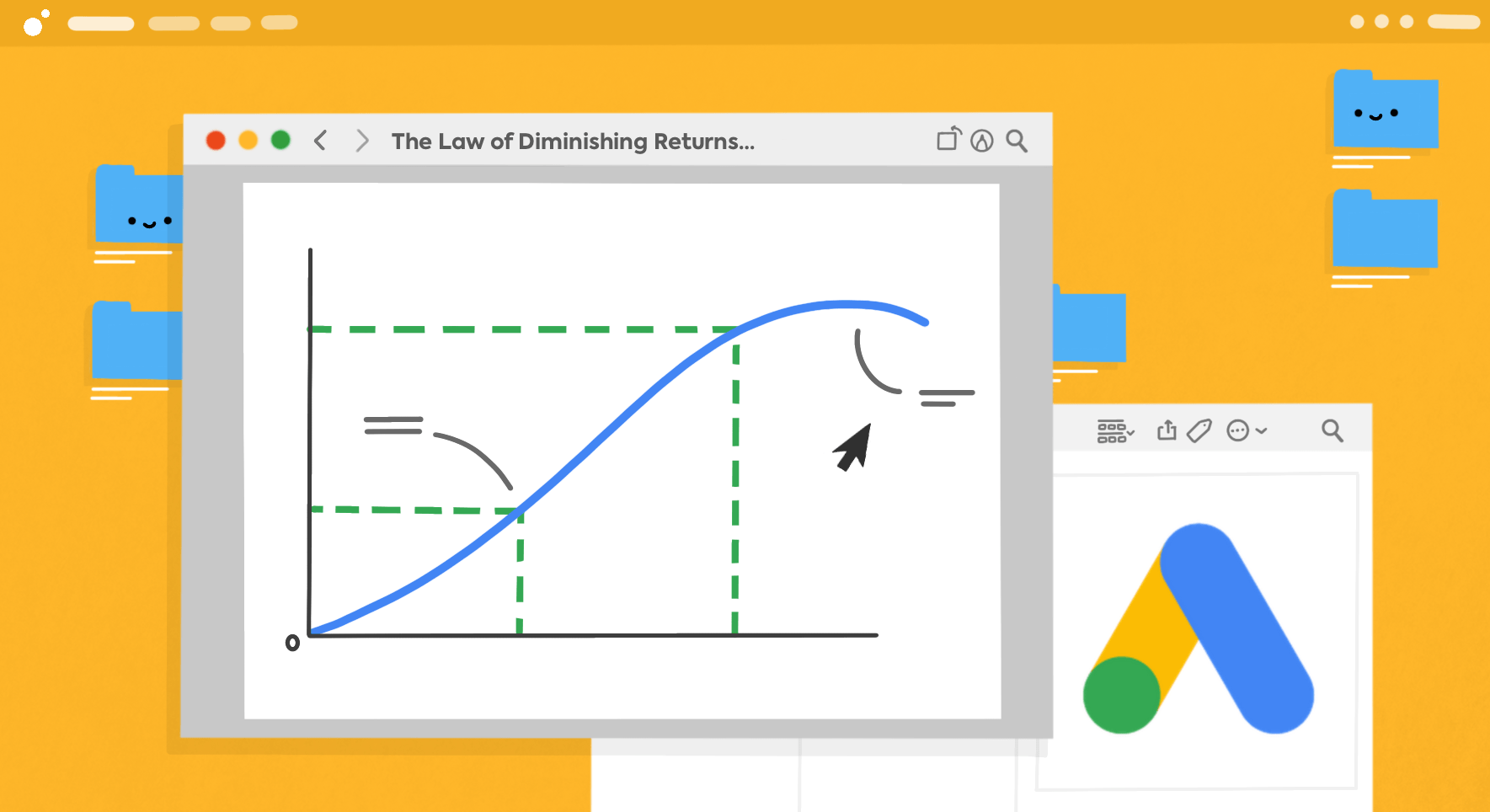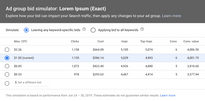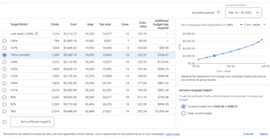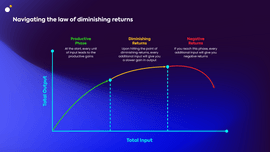Good budget management is essential for performance marketing success. The best PPC campaigns maximise return on investment while eliminating wasted spend, keeping your costs under control while getting great results.
But even if your strategy seems to be working, there’s always a chance you could get more from your marketing spend by adjusting your PPC bids and budgets. That’s where Google Ads Bid Simulator comes in.
Google Ads Bid Simulator is a useful (but often underutilised) forecasting tool. It can help you create a business case for your PPC budget, while assisting CFOs and other C-suite executives with financial forecasting. With insights from Bid Simulator, you can spend your ad budget more efficiently, make the right bid decisions at the right time, and ultimately get more from your ad spend.
In this article, you’ll learn how Google Ads Bid Simulator works, which types of simulators you can use, and the benefits and pitfalls of working with bid simulators.
What Is Google Ads Bid Simulator?
Google Ads Bid Simulator is a tool that helps you estimate the impressions, clicks, and conversions you can expect by adjusting your PPC bids, without making any actual changes. You can use the bid simulator at campaign, ad group, and keyword level.
The bid simulator will show you:
- How many clicks you can expect over the selected simulation period.
- The total estimated cost of those clicks.
- How many impressions you can expect, including the number of impressions in the top spot.
- How many conversions you can expect, and the value of those conversions.
- The additional daily budget required to achieve these estimated results.
You can use this tool to simulate the impact of changing your both manual and smart bidding strategies, such as target ROAS and target CPA.
Eliminate Fake Traffic From Search Campaigns
Ads are for humans, not bots. Get a demo and save up to 25% of your advertising budget by automatically eliminating fake ad engagements across all paid channels.
How Do Bid Simulators Work?
Google Ads Bid Simulators use several data sources to estimate the impact of your bid adjustments. These include:
- Historical data — Your previous Google Ads campaign data informs the simulation, so the estimations are based on your own results. Bid simulations become more accurate over time.
- Quality score — Google rewards good Quality Scores with lower cost-per-click rates, so it will take your existing Google Ads Quality Score into account.
- Keyword volume — The amount of traffic your keywords generate will impact the estimated CPC, with high-volume keywords usually attracting higher costs.
- Competition — High keyword competition can also drive up costs, so the bid simulation will consider this.
Importantly, Bid Simulator doesn’t account for your actual conversion rate. Instead, it assumes a flat conversion rate, which can lead to inaccuracies (more on this later).
Bid simulators work in a similar way for both manual and smart bidding strategies.
Let’s say your maximum bid in a manual CPC campaign is set at £5. Using Bid Simulator, you can forecast the outcome of changing your maximum bid to £4, £6, £10, or any number of other bid options. As well as seeing the forecasted impact in terms of clicks, impressions, and conversions, you’ll also see how much your overall daily budget needs to change to achieve those results.
For campaigns or ad groups that use smart bidding strategies, you can test the impact of changing your target ROAS or target CPA. For example, reducing your target ROAS may increase your costs, but can also boost the conversion value of each purchase.
Bid Simulator offers useful insights, but you’ll need to analyse the estimated results carefully before applying any bid changes. In the example above, increasing your target ROAS from 150% to 167% will slightly reduce your cost-per-click, but will also give you fewer conversions, a lower conversion value, and you’ll still need to increase your daily budget. So look at the full picture when considering simulated results.
Where to Find Google Ads Bid Simulator
You’ll find the Google Ads Bid Simulator graph icon in the budget column for campaigns, or the default max CPC column for ad groups and keywords:
Clicking the Bid Simulator icon will open up the tool so you can test your bid changes.
You can also access bid simulation data for keywords by customising the keyword report. The following checked columns can be added to your report to display simulation results side-by-side:
Types of Bid Simulators
There are several different types of bid simulator available in your Google Ads account. Compare the key differences between each bid simulation type in this table:
| Manual CPC Bid Simulators | Smart Bidding Simulators | Campaign Bid Simulators | Bid Adjustment Simulators | |
| Subtypes | None | Target ROAS, target CPA, maximise conversion value, maximise conversions, maximise clicks, target impression share | Video campaigns, Hotel campaigns, Shopping campaigns, and App campaigns | Call and device bid adjustment simulator |
| Networks | Search, Display | Search (all subtypes), Display, Shopping, App (target CPA only) | Search, Display, Shopping, Video, Hotels, Apps | Search, Shopping |
| Levels | Campaign, ad group, keyword | Campaign, ad group | Campaign | Campaign |
| How it works | Tests specific maximum bid values | Tests different values depending on your smart bid strategy (e.g. % for target ROAS, £ for conversion value) | Tests the impact of bid changes on specific products (e.g. cost-per-view for YouTube video views) | Tests the impact of adjusting your call interaction bid or device bid |
The type of bid simulator you need will depend on your existing campaign settings and the bid adjustment you want to test.
5 Reasons Bid Simulator Might Be Unavailable
Sometimes the Google Ads Bid Simulator tool is unavailable when you try to click it. If the bid simulator is unavailable, the graph icon will be greyed out with a line through it, as you can see in the third row of this screenshot:
There are a few reasons why you might not be able to use Google Ads Bid Simulator:
- You don’t have enough data — The tool relies on accurate historical data from your account to give you reasonable predictions. It takes time to gather this data, so Bid Simulator may not be available for recently added ad groups and campaigns.
- Your campaign uses a shared budget — Campaigns that use shared budgets won’t work with the campaign bid simulator.
- You’re running an experiment — The simulator isn’t available for search campaigns that are part of a current experiment, or an experiment that ended within the last eight days.
- Wrong network type — Not all types of simulator are compatible with all Google’s PPC networks. For example, bid adjustment simulators only work on manual Search and Shopping campaigns.
- You’ve reached your average daily budget — Campaigns that have reached their average daily budget at least once in the last week may not be eligible for bid simulation.
Benefits of Using Google Ads Bid Simulator
Google Ads Bid Simulator is a great tool for performance forecasting, budgeting, and campaign optimisation. Here are 4 reasons to use Google Ads Bid Simulator as part of your performance marketing strategy.
1. Improve Performance Forecasting and Budgeting
Kareyna Miller, a certified public accountant and CFO, explains the importance of financial forecasting for any business:
“Budgets are for cost control, while financial forecasts involve taking baseline numbers and using those to predict future revenues and expenses over a period of time. So you can really see how your business is going to grow. […] For financial forecasts, just like for budgets, accuracy counts. You want to make sure that you’re using realistic numbers.”
This is where Bid Simulator can help. While there are some accuracy quirks to note, bid simulator tools use your existing data to give you a reasonably realistic idea of how your changes will impact campaign performance.
Plus, by viewing your simulation data holistically, you can model multiple changes to your existing PPC setup and see if you can get more valuable conversions while reducing your spend.
2. Create a Business Case For PPC Investment
As more marketing teams are tightening their belts, using Bid Simulator can help you make a business case for maintaining or even expanding your PPC budget.
Using hard historical data helps you make data-driven decisions more confidently. For example, if you’re likely to double conversions with a PPC budget increase of 10%, it’s more difficult to deny the investment.
Similarly, you can project the impact of scaling back your PPC investment too aggressively.
3. Manage and Distribute Your PPC Budget Effectively
Even if you don’t see an immediate need to increase your PPC advertising bids, Google Ads Bid Simulator can help you reallocate your funds to the most effective campaigns, ad groups, and keywords.
Using Bid Simulator as a bid management tool, find out where you can decrease budgets without damaging conversions, and where a bid increase will result in the biggest gains. Redistribute your budget to the campaigns that are most likely to help you achieve your advertising goals.
4. Test Smart Vs Manual Bidding
If you’re cautiously considering moving to a smart bidding strategy (or vice versa), Bid Simulator can help you find out which strategy is most effective based on your budget. Model what happens if you change your smart bids to a fixed-value, or change your max CPC bids to target ROAS.
Be cautious about applying changes directly in Bid Simulator, as campaign level settings will override keyword and ad group level bids.
Navigating the Law of Diminishing Returns
The law of diminishing returns always applies in PPC. After a certain point of investment, your campaign performance will plateau and eventually drop: the extra sales you earn will be worth less than the money you invest in them.
Yoann Ferrand, Founder of In-House Partners and PPC Consultant at Opteo, explains how the law of diminishing returns applies to advertising in a recent Lunio webinar:
The main thing about the law of diminishing returns is that every additional spend you’re going to bring is not going to provide you the same level of results. Every additional spend will bring you less conversions, new customers, or profit than you expect.
A common challenge in PPC is to try to scale way too fast and basically create unprofitability, to not achieve your targets. Another challenge is that sometimes this curve will actually be flat. So it does not matter how much more investment you put in, it’s still going to bring you the same conversion [rate].
Google Ads Bid Simulator can help you navigate the law of diminishing returns more effectively. It allows you to test any bid-based hypothesis: will increasing my bids by X deliver a significant increase in conversions?
This approach helps you maximise results from the upwards trajectory of the curve before you plateau. When you reach the point where extra investment doesn’t produce better results, you’ll know to be cautious about ploughing more money into your campaigns.
The Pitfalls of Google Ads Bid Simulator
While Google Ads Bid Simulator is a fantastic tool for performance forecasting, there are a few potential pitfalls to note before you base your entire budget around it.
Here are some of the most common problems Bid Simulator users might encounter:
- It’s a simulation, not a guarantee —- While Bid Simulator offers useful insights, use caution and your own knowledge and experience when analysing its output.
- Macro-economic factors can play a part — Google doesn’t take external factors into account when simulating the impact of bid changes, so you’ll need to plan for these outside the simulator.
- Bid simulation isn’t always available — As we’ve mentioned, some factors can prevent you from simulating bid changes on certain keywords, ad groups, or campaigns.
- Google assumes a flat conversion rate — Your conversion rate changes from day to day, but Google doesn’t account for this when simulating bid changes.
This last point is critical to consider. Yoann explains further:
One thing you need to be careful of with Bid Simulator is that Google assumes that there is a flat conversion rate. So whenever Google recommends that you increase or decrease investment, bear in mind that Google doesn’t consider your conversion rate.”
“We use the bid simulator with the API and we try to select more realistic targets so that you can achieve your results. That’s something quite advanced, quite difficult to get, but I really advise you to look more into Bid Simulator data in general, and to look at what Google suggests you do, and to make sure you’re not going to increase investment for the same conversions.
Boost Your PPC Bids and Budgets With Lunio
If you’re looking to get more from your PPC budget, Lunio is an essential tool. Lunio eliminates fake invalid traffic from your PPC campaigns, so 100% of your budget is spent on clicks from genuine humans.
With Lunio, you can:
- Reduce wasted ad spend and reallocate it to your best performing campaigns.
- Prolong the productive phase of the diminishing returns curve by removing invalid users from your campaigns.
- Make performance forecasting more predictable by eliminating external factors that can skew your results.
Eliminate Fake Traffic From Search Campaigns
Ads are for humans, not bots. Get a demo and save up to 25% of your advertising budget by automatically eliminating fake ad engagements across all paid channels.











